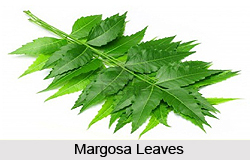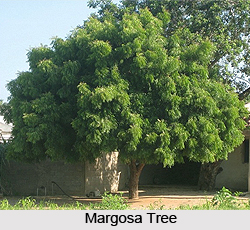 One of the most ordinary South Indian Customs is perhaps that in connection with the use of the margosa i.e. tnelia azadirachta leaves. It has been the popular belief from time immemorial that evil spirits are scared away by the special properties possessed by the margosa leaf. When women and children start on a journey, a few margosa leaves are given to them or placed somewhere on their bodies securely. Evil spirits are generally supposed to possess only women and children and not strong-willed men. But children and weak women, armed with a few margosa leaves, are believed to be safe. The reason for this is not far to seek perhaps. Certain insects like the flies gather generally in unclean places and upon rotten things. Fine strong scents are abhorrent to them and so they run away from places where they are kept. Similarly the good and evil spirits are attracted and repelled by magnetism, animal and vegetable. The Indians believe that certain evil spirits are capable of creating death dealing microbes in the human body and make occur epidemics like small-pox, cholera, etc. But the presence of the margosa leaves perhaps nullifies their efforts in this direction and foiled in their attempts as a result they go away. Whatever may be the properties of the margosa leaves, the people do believe that they have the power to shield them from harm from epidemics or at least to lessen their virulence.
One of the most ordinary South Indian Customs is perhaps that in connection with the use of the margosa i.e. tnelia azadirachta leaves. It has been the popular belief from time immemorial that evil spirits are scared away by the special properties possessed by the margosa leaf. When women and children start on a journey, a few margosa leaves are given to them or placed somewhere on their bodies securely. Evil spirits are generally supposed to possess only women and children and not strong-willed men. But children and weak women, armed with a few margosa leaves, are believed to be safe. The reason for this is not far to seek perhaps. Certain insects like the flies gather generally in unclean places and upon rotten things. Fine strong scents are abhorrent to them and so they run away from places where they are kept. Similarly the good and evil spirits are attracted and repelled by magnetism, animal and vegetable. The Indians believe that certain evil spirits are capable of creating death dealing microbes in the human body and make occur epidemics like small-pox, cholera, etc. But the presence of the margosa leaves perhaps nullifies their efforts in this direction and foiled in their attempts as a result they go away. Whatever may be the properties of the margosa leaves, the people do believe that they have the power to shield them from harm from epidemics or at least to lessen their virulence.
Legend of Margosa Tree
Margosa tree was and is being considered to have excellent medicinal properties. The fact can be supplemented by the following popular story.
Once there lived a husband and a wife in a village. The husband was about to start on a long journey but the wife did not like it and desired if possible to stop him from undertaking it. She consulted an old woman, who was a friend of hers. She advised her to obtain a promise from her husband that he would sleep only under tamarind i.e. tamariudus indica trees on his way to the place of pilgrimage. She also told her to seek promise that on his return journey he will sleep under margosa trees. The woman did obtain the said promise from her husband. The husband started his journey and kept up his promise to his wife to sleep under tamarind trees. A few days of sleep under the tamarind trees made him very sick and so he had to give up his journey and turn homewards. Remembering the promise made to his wife, he began to sleep under margosa trees on his return journey when within a few days he was cured of his illness.
The above story is of course intended to show the popular belief in the efficacy of the margosa tree in curing diseases, and it also shows the belief people had in the tamarind tree. They used to say that tamarind is to a house what the tiger is to the forest. It is considered to be such an injurious thing as to make a sickly man worse if possible.
Belief Revolving around Margosa Leaves
In front of the houses whose inmates are laid up with small-pox, measles, etc., one might invariably see a bunch of margosa leaves thrust in the eves. Quantities of the leaves may also be seen scattered near and around the patients. Pregnant women and women in confinement are considered to be susceptible to the influence of bad spirits. Perhaps the magnetism, etc., emanating from them and the new born babies are agreeable to them and consequently attract them in large numbers. So to scare away such evil spirits, a bunch of margosa leaves is thrust in the eves of the roof directly in front of the house. And it should be done immediately after the confinement of a woman in a house.
 Most people do not believe in super physical beings like the evil spirits referred to above nor do they believe that they could create germs and microbes which are the root causes of all epidemics and other diseases. But one and all do believe that the germs and microbes cause various diseases in human beings and that cholera, plague, small-pox and many other epidemics may be and are traced to them.
Most people do not believe in super physical beings like the evil spirits referred to above nor do they believe that they could create germs and microbes which are the root causes of all epidemics and other diseases. But one and all do believe that the germs and microbes cause various diseases in human beings and that cholera, plague, small-pox and many other epidemics may be and are traced to them.
Medicinal Properties and Usages of Margosa Leaves
Various drugs are being experimented upon by medical experts to find out the medicinal properties of Margosa Leaves. This is because of the fact that drugs could destroy germs and microbes that are valuable. This also happened because the people of ancient days would not have placed so much confidence in the efficiency of margosa leaves, etc. If experience had not shown them that they were productive of good and beneficial results, margosa leaves deserve to be experimented upon.
The bark of the old margosa tree is said to possess excellent medicinal properties and physicians often administer its decoction or medicine in its decoction to affect certain cures in certain cases of fever and so on. The tender leaves are said to have the power to kill the worms in the stomach and the intestines. Consequently, it can easily be said that the leaves do possess germicidal properties.
A woman soon after delivery is susceptible to the attack of any disease and consequently every precaution should be taken to destroy microbes if any that may be brought into the house by men, animals and things. The margosa leaves, though they may not be able to destroy the microbes completely, appear at least to possess the properties of paralyzing the activities of the germs. The germs can be causing contagious diseases like small-pox. Some even think that the smell of the margosa leaves prevents the breeding of the microbes and hence the evil is reduced to a minimum and the attack may not grow worse or virulent. The margosa leaves do possess some properties in the manner suggested above there is no gainsaying. People believe that the tamarind tree would enhance any disease while the margosa tree would cure even the worst type of sickness, if patients were brought near and kept there sufficiently long. Avenues and groves of margosa trees may be created near isolation hospitals and some patients kept near them or in them and the effect should be noted. Some wise men are of opinion that groves and avenues of certain trees should be near hospitals to make experiments. Patients suffering from fever, small-pox, etc., may be placed in buildings in the middle of the margosa groves, since it is found that the bark of this tree cures fever and checks the virulence of small-pox. Similarly, a coconut grove may be made use of to experiment on men having weakened systems by the exhaustion of nerves. A grove of Punga trees i.e. Pongamia glabra, to cure lung diseases like consumption (another name of Tuberculosis), asthma and so on.
The curative properties of plants should first be ascertained and patients should be placed in the atmosphere of such living plants as are supposed to have properties to cure particular diseases. It is also suggested that combined groves of trees of diverse kinds may be formed guided by the ingredients going to make up mixture for various ailments.





